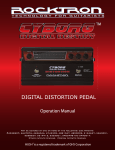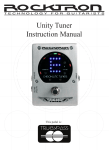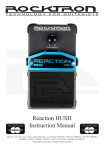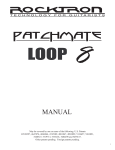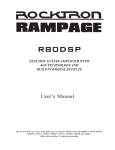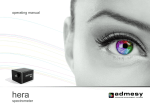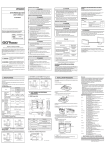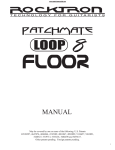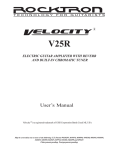Download Rocktron Cyborg Specifications
Transcript
Your Cyborg™ Digital Delay pedal has been designed to comply with the following Standards and Directives as set forth by the European Union: Council Directive(s): 89/336/EEC Electromagnetic Compatibility Standard(s): EN55013, EN50082-1 This means that this product has been designed to meet stringent guidelines on how much RF energy it can emit, and that it should be immune from other sources of interference when properly used. Improper use of this equipment could result in increased RF emissions, which may or may not interfere with other electronic products. To insure against this possibility, always use good shielded cables for all audio input and output connections. This will help insure compliance with the Directive(s). For more information about other Rocktron products, please see your local dealer or one of our importers closest to you (listed on the Rocktron website - www.rocktron.com). Precautions Read all instructions contained in this manual. Keep these instructions Heed all warnings Follow all instructions. Do not use this apparatus near water. Clean with dry cloth Copyright © 2006 GHS Corporation All Rights Reserved. Precautions Continued.... Do not block any ventilation openings (if applicable). Install in accordance with the manufacturer’s instructions. Do not install near any heat sources such as radiators, heat registers, stoves or other apparatus (including amplifiers) that produce heat. This product is supplied with and runs on a 9VDC adapter. Only used attachments/accessories specified by the manufacturer. Do not use this product with any case, stand tripod, bracket or table that is not specified by the manufacturer. Insure that the case, stand, tripod, bracket etc. is properly adjusted and setup (follow all instructions). Extra care and caution should be taken to avoid tip over and injury. Unplug this apparatus during lightning storms or when unused during long periods of time. Refer all service to qualified service personnel. Servicing is required when the apparatus has been damaged in any way, such as power supply or plug is damaged, liquid has been spilled or objects have fallen into the apparatus or if the apparatus has been exposed to rain or moisture, does not operate normally or has been dropped. DO NOT ATTEMPT TO SERVICE THIS EQUIPMENT. QUALIFIED PERSONNEL SHOULD SERVICE THIS EQUIPMENT ONLY. DO NOT MAKE ANY INTERNAL ADJUSTMENTS OR ADDITIONS TO THIS EQUIPMENT AT ANY TIME OR TAMPER WITH INTERNAL ELECTRONIC COMPONENTS AT ANY TIME. FAILURE TO FOLLOW THESE INSTRUCTIONS MAY VOID THE WARRANTY OF THIS EQUIPMENT AS WELL AS CAUSING A SHOCK HAZARD. OPERATING TEMPERATURE Do not expose this unit to excessive heat. This unit is designed to operate between 32 F and 104 F (0 C and 40 C). This unit may not function properly under extreme temperatures. Introduction Congratulations on your purchase of the Rocktron Cyborg Digital Delay. The Cyborg Digital Delay is one of a series of “Digital Destiny” stomp boxes that break new ground in the world of floor effects excellence. Simple to use, while offering instant access effects, or satisfying those who crave more complex control and the ability to create a plethora of additional presets, the Cyborgs are low noise, easy operation effects! Rocktron has designed the Cyborg series around a state-of-the-art Motorola® DSP engine. We’ve included our HUSH® noise reduction technology, and provided you with full bandwidth performance. We’ve cut no corners in the design of these digital stomp boxes. Cyborgs are fully MIDI programmable and controllable and Cyborgs can be chained together and controlled by a single Rocktron MIDI controller. Look for other Cyborg Digital Destiny pedals at your Rocktron retailer. Connection 1 - Standard Connection Connection 2 - Effects Loop Connection 3 - with a Noisy Distortion Pedal Descriptions 1 Preset Select Knob - this knob allows you to select the “preset” you desire. Eight presets are available with this control. As the knob is turned the LED under the selected preset will light. 2 LED Display - see following page for detailed descriptions of display. 3 Time Select Knob - this knob allows you to increase or decrease the delay time of the preset. 4 Repeat Knob - this knob allows you to select the amount of times the delay signal will “repeat” itself. As you turn the knob you will note that the LEDs in the LED display will light in order from left to right as you increase the amount of repeats. As you decrease the amount of repeats the LEDs will turn off from right to left. 5 Level Knob - this knob determines the “volume” of the delay relative to the dry signal. As you increase the delay volume the LEDs in the LED display will light in order from left to right and stay lit. As you decrease the volume of the delay the LEDs will turn off from right to left. 6 DC OnTap Power input. Use the supplied Rocktron DC OnTap adapter to power your Cyborg pedal. Plug into a standard wall outlet and follow all safety precautions. 7 Input Jack - plug your guitar into this jack. See preceeding pages for standard connections. 8 HUSH Switch - The Cyborg Digital Delay pedal includes Rocktron Patented Digital HUSH noise reduction. Select “ON” if the Delay pedal is placed after a noisy distortion pedal. Select “OFF” when using clean tones. For more on the HUSH and how it works, see the HUSH Section of this manual. Descriptions Continued 9 Tap/Store Switch and Store LED - this switch allows you to set the delay time by “tapping” the switch with your foot and to STORE changes to the preset. TAP function - Each of the 8 presets have a different tap parameter as indicated on the top line of the LED Display (see point 2). The Tap parameter is set (or fixed) for each preset and is not changeable. Simply press the TAP button 4 consecutive times at the tempo you want . The delay will automatically be quantized to one of the selected preset TAP Button Parameters as shown below. The blue LED will flash to indicate the quantized delay rate. The resulting delay time can be: One-half of the time between taps (8th Note) Two-thirds of the time between taps (Triplet) Equal to the time between taps (1/4 Note) Two times the amount of time between taps (1/2 note) Four times the amount of time between taps (Whole Note) STORE function - Use this function to STORE (or save) changes you have made to a preset. To operate the STORE function, press and hold the TAP/ STORE switch down for 2 seconds. This will save the changes to your preset. The TAP/STORE LED will “hold on” and then return to flashing to confirm the storgin process has been completed. 10 On/Off Footswitch and LED - this footswitch is used to turn “ON” or “OFF” the Cyborg Delay. When the LED is lit , the delay is “ON” 11 Output Jack - Using a standard guitar cable with a 1/4” jack, plug into your amplifier or the next effect pedal in your signal chain. 12 MIDI Jack - Using the Rocktron MIDI Breakout Cable (sold separately) you can connect the Cyborg Pedal to a Rocktron MIDI Footcontroller such as the Rocktron MIDI XChange, MIDI Mate or All Access. This feature allows you to access all 64 presets and even connect other Cyborg pedals to be controlled by the MIDI footcontroller. HUSH® is Rocktron's patented single-ended noise reduction system, and is available in all presets. The HUSH system provided in the Cyborg is a fully digital implementation, modeled after the latest analog HUSH design, achieved through Digital Signal Processing (DSP). The low level expander of the HUSH system operates like an electronic volume control. The analog version of the HUSH system utilizes a voltage-controlled amplifier (VCA) circuit which can control the gain between the input and the output from unity gain to 30, 40 or even 50dB of gain reduction. When the input signal is above the userset threshold point, the VCA circuit remains at unity gain. (This means that the amplitude of the output signal will be equal to that of the input signal.) As the input signal level drops below the user preset threshold point, downward expansion will begin. It is at this point that the expander acts like an electronic volume control, gradually decreasing the output signal level relative to the input signal level. As the input signal drops further below the threshold point, downward expansion increases (see figure below). A drop in the input level by 20dB would cause the output level to drop approximately 40dB (i.e., 20dB of gain reduction). In the absence of any input signal, the expander will reduce the gain so that the noise floor becomes inaudible. LED Display The Cyborg’s LED Display consists of 8 LEDs that are used to visually show the user: 1) The PRESET selected 2) The TIME parameters available to the selected preset (called TIME CONTROL) 3) The TAP BUTTON parameter setting for the selected preset 4) The LEVEL setting (MIN through MAX) of each of the preset’s parameters for the Time Control knob (point 3), the Repeat Control Knob (point 4) and the Level Control knob (point 5). As an example, lets choose preset 1. First, turn the Preset Knob (point 1) until the LED under the number 1 lites. You now have selected Preset 1. On Preset 1 you have the following parameters available 1) TAP BUTTON - The parameter available on Preset 1 is an 1/8 note parameter. This means that on Preset 1 the Cyborg will measure on half of the time between taps to set the delay time when using the TAP/STORE footswitch to determine the delay time. 2) TIME CONTROL - The Time of the delay for this preset is 0ms-500ms. This time can be selected by either using the Time Control knob (point 3) or the TAP/ STORE button. When using the Time Control knob, the LEDs in the LED Display will start lighting from left (MIN) to right (MAX) as you increase the delay time. The LEDs will turn off from right to left as you decrease the delay time. Additionally the blue STORE LED will flash at the delay time selected. NOTE: When using the TAP/STORE button the delay time change will only be indicated by the flashing of the STORE LED. This LED will flash quicker when a short delay has been tapped or will flash slower when a longer delay has been tapped. At this point, if you turn the TIME Control one click the LED DISPLAY will immediately show you if the delay is long or short by how many LEDs light on the display. 3) The LEVEL setting parameter shows the LEVEL settings of the following parameters: o The Time Control Knob (Point 3). Turning the Time Control knob will light LEDs in the display to show you the Delay time length that you have selected within the preset. To see the current delay time of the preset , turn the knob only one click. This will cause the LEDs to light showing your current setting. To change the setting continue turning the knob. Turning the knob clockwise will increase the delay time and the LEDs will light from left (MIN) to right (MAX). To shorten the delay time turn the knob counter-clockwise and the LEDs will turn off from right (MAX) to left (MIN). o The Repeat Control Knob (point 4). Turning the Repeat control knob will light LEDs in the display to show you how many “repeats” of the delay are selected within the preset. To see the current number of repeats for this preset, turn the knob only one click. This will cause the LEDs to light showing your current setting. To change the setting continue turning the knob. Turning the knob clockwise will increase the amount of repeats and the LEDs will light from left (MIN) to right (MAX). To decrease the amount of repeats turn the knob counter-clockwise and the LEDs will turn off from right (MAX) to left (MIN). o The Level Control Knob (point 5). Turning the Level Control knob will light LEDs in the display to show you level of the delay of the preset relative to the unaffected dry signal. To see the current level for this preset, turn the knob only one click. This will cause the LEDs to light showing your current setting. To change the setting continue turning the knob. Turning the knob clockwise will increase amount of wet (effected) signal relative to the dry (unaffected) signal and the LEDs will light from left (MIN) to right (MAX). Turning the knob counterclockwise will decrease the amount of wet signal relative to the dry signal and the LEDs will turn off from right (MAX) to left (MIN). LED Display...continued... Tap Button and Time Control The top line in the LED display is the TAP BUTTON. As described in (point 9) of the description section of this manual, this line indicates the tap parameter available on each preset when using the TAP/STORE footswitch to determine the delay time. Please note that the tap parameters are only available on the selected preset. The next line down is the TIME CONTROL line. This line indicates the available DELAY TIME on each preset. Here is a description of each preset and the parameters available: Preset 1 has an 1/8 note tap parameter. This parameter measures one half of the time between taps. The Delay time available on this preset is 0ms-500ms. Preset 2 has a Triplet tap parameter. This parameter measures twothirds of the time between taps. The Delay time available on this preset is 0ms-666ms. Preset 3 has a 1/4 note tap parameter. This parameter is equal to the time between taps. The Delay time available on this preset is 0ms-1 second. Preset 4 has a 1/2 note tap parameter. This parameter is equal to two times the amount of time between taps. The Delay time available on this preset is 0ms-1 second. Tap Button and Time Control Line...continued Preset 5 has a Whole note tap parameter. This parameter is equal to 4 times the amount of time between taps. The Delay time available on this preset is 0ms-2 seconds. Preset 6 tap parameter is actually a “HOLD” function. Using the TAP/ STORE footswitch you can create a “loop” allowing you to be able to play over a riff. The Delay time available on this preset is 0ms-2 seconds. For more details on how to use the HOLD Function see HOLD Function Section of this manual. Preset 7 has a 1/4 note tap parameter. This parameter is equal to the time between taps. The Delay time available on this preset is 0ms-1 second. This effect is called “PHAZDLY.” The input signal is mixed with the modulated phased delay line repeats to produce a unique, textured PSYCHEDELIC effect. Preset 8 has a 1/4 note tap parameter. This parameter is equal to the time between taps. This preset has the “REVERSE” delay effect assigned to it. The reverse effect actually records the note and returns it in reverse. With the effect the LEVEL control knob controls the LEVEL of the dry (unaffected) signal. Thus to hear the dry signal and the reverse effect turn the level control clockwise until the desired level of dry signal is reached. To hear less dry signal and only the reverse delay turn the LEVEL Control knob counter clockwise until the desired level is reached. Hold Function The Hold function allows you to record a quick riff which you can then play over. The HOLD function is only available on Preset 6. When you active preset 6 by turning on the delay using the ON/OFF switch (point 10) the delay will function as it would normally. Now, to activate the HOLD function follow these steps: 1) Play a riff until it is in time with the delay (note that the delay rate can be changed by tapping the TAP/STORE button (point 9)). 2) Once you are in time, depress and hold down the TAP/STORE button (point 9) until you hear the riff repeating. 3) Take your foot off of the TAP/STORE button and stop playing. You should now hear the riff repeating automatically (or HOLDING) and the LED will be lit. 4) Now, before you start playing again, use the ON/OFF switch (point 10) to turn off the delay. The riff will continue to play. You can now play or solo over the riff without changing the riff. 5) You can then add more riffs (or layer more notes) over the playing riff by playing along with the riff until you are in sync with it. While you are playing turn the ON/ OFF button (point 10) ON. Continue playing until you hear what you have just played repeat. Using the ON/OFF button, turn the delay off. Now you should be hearing both riffs playing at the same time. At this point you can jam over the playing riffs. 6) You can continue to add riffs or layer notes over the playing riff by repeating step 5. 7) To turn OFF the playing, riff or pattern press and release the TAP/STORE button with your foot once, this will turn OFF the HOLD function and TAP/STORE LED will blink at the delay rate and the riff/pattern will decay. MIDI The Cyborg Delay pedal has a MIDI jack that allows you to access an additional 56 user presets. Using the Rocktron MIDI Breakout cable (sold separately) you can access these additional 56 presets (64 total) by using a Rocktron MIDI Controller such as the Rocktron MIDI XChange, MIDI Mate or All Access. This will also allow you to connect and control additional Rocktron Cyborg pedals. Note that 63 presets on the Cyborg Delay may be modified and stored (note that preset 6 - HOLD - cannot be programmed from the front panel). When using the option MIDI Breakout cable to access the remaining 58 presets you will find that these locations have the original factory presets already stored. Example: Preset 1-8 are repeated in MIDI recall locations, 9-16, 17-24, 25-32, 33-40, 41-48, 49-56 and 57-64. Also note that the preset locations 1-64 will be recalled when receiving program changes 65-128 thus allowing all MIDI program changes 1-128 to be accepted See MIDI connections using the optional MIDI Breakout cable on the following pages. Cyborg MIDI Preset Programming Connect Midi X-change to CYBORG using the optional Midi Breakout cable as shown in MIDI Connection 1 and 2. 1) To program any preset simply recall the preset to be programmed with your MIDI CONTROLLER. For Example, preset 32... 2) Now adjust preset with control knobs to make your desired changes. 3) Once you have created your preset press and hold down the TAP/STORE Button on the Cyborg pedal until the led indicates the store process is completed. (LED will hold bright then return to Tap Delay blinking status) MIDI - Connection 1 MIDI - Connection 2 Specifications Maximum Input Input Impedance Current Consumption +3dBu 1M Ohm 1000ma Freq. Response 20Hz-16Khz A-Weighted Dynamic Range 93dBu Power Requirements Dimensions Rocktron OnTap DC 9V Adapter 10.5” x 6” x 2.25” Notes: Notes: Notes: Rocktron - A Division of GHS Corporation 2813 Wilber Ave. Battle Creek MI 49015 USA Rocktron Phone: 1-(269)-968-3351 Email: [email protected] www.rocktron.com The Rocktron, Cyborg, PHAZDLY names and logos, this pedal’s shape, design and graphics and this manual’s layout, descriptions and designs are TM, C and R GHS Corporation, Battle Creek, MI 49015 - - All Rights Reserved 2006-0001 Rev. 05/19/06

























